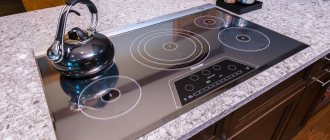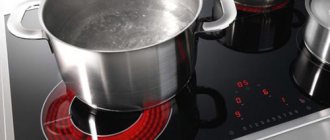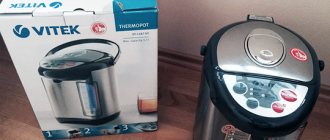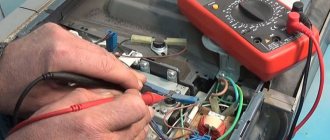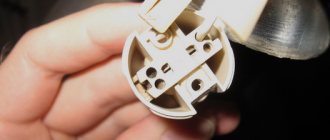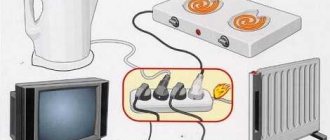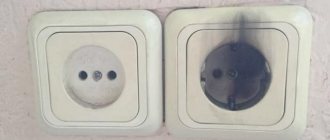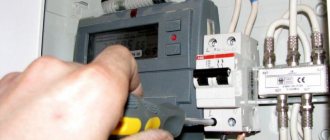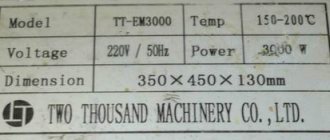Users prefer electric, induction and gas stoves for cooking. If they malfunction, it is better to contact specialists. But, if you have the skills, knowledge and ability to work with tools, you can repair household kitchen hobs yourself.
A hob is a stove with a ceramic or glass-ceramic coating
Types and design of hobs
The hob is an electric or induction hob covered with ceramic or glass ceramics. The following surfaces are currently produced:
- induction They work on the principle of electromagnetic induction. Cookware made from special materials and the burner create a circuit with electrical oscillation;
- spiral. Current passes through the spiral element, then heat is released, which heats the cookware;
- corrugated tapes. The operating process is similar to spiral devices. The only difference is the accordion heater;
- halogen. A stove with a tubular heater filled with halogen vapor heats up in 2 seconds. After warming up, the heating element turns on.
To quickly detect problems during the repair process, it is important to know the structure of the equipment.
How does the hob work?
The main components of the device are burners with contacts for connection and a thermostat. The burners are connected to the control panel via contact wires. Using a thermostat, heating is controlled and power is turned off. The control unit is responsible for executing the main programs. To turn on, use a button, gas tap or cord with a plug.
The main elements of the hob are the burners and the control panel
Types of heating elements of cooking surfaces
Several types of burners are used in hobs:
- induction - they only heat the dishes, while the work area itself is practically cold. Temperature and power can be adjusted from minimum to maximum;
- rapid - spirals that heat up and cool down in 10 seconds;
- halogen - a spiral with a red backlight that heats up in 2 seconds and releases a large amount of heat;
- Hi-Light is a very thin spiral tape that heats up instantly. The high-resistance resistance of the alloy ensures minimal energy consumption - up to 2 kW per hour;
- gas burners - automatically supply fuel, are smoothly regulated and heat up gradually;
- electric - cast iron pancakes, the heating of which is indicated by a red circle in the center.
Interesting to know! Depending on the diameter of the heating element, the flame of gas models can burn in 2-3 rows (“crowns”).
If you have a faulty electric ignition
Almost all devices are now equipped with it, which has a positive effect on ease of use. Let's first define how electric ignition works and works.
Electric ignition consists of four parts:
- transformer (unit) operating from a 220 V electrical network;
- electrical wire leading from the transformer to the ignition mechanism;
- ceramic candle;
- ignition button located on the control panel, next to the rotary switches.
The mechanism of electric ignition is as follows:
- When you press the button, the circuit closes;
- The transformer generates the current for the spark;
- The pulse is supplied through the wires to the gas burner;
- The ceramic candle produces a spark and the burner ignites.
It is noteworthy that the candle fires on all burners without exception, however, only the one that receives gas is ignited.
It is very important to ensure that the network always has one voltage - 220 V. To protect your stove, you can buy a household voltage stabilizer, which will protect you from unexpected current surges. Otherwise, short circuits and unstable operation of the network negatively affect the electric ignition and can cause breakdown. If your hob exhibits the following malfunctions, then the problem is with the ignition:
- you turn on the button, but the ignition does not work;
- one or all spark plugs spark;
- you release the button, and the ignition works.
You turn on the button, but the ignition does not work
The first and most common reason is contamination of the mechanism button and/or burner with dirt and combustion waste . Cooking food entails splashing fat and food all over the stove, so this problem is not uncommon. Clean the ignition button, wipe the burner, clean the nozzle with a needle or any other thin stick, wait until everything is dry.
Care of gas hobs
One or all spark plugs are sparking
If the spark plugs on all burners sparkle orange or yellow and operate intermittently, then the problem may be a faulty electric ignition unit. It needs to be replaced, but doing it yourself is extremely difficult. The block is located in the middle of the panel; it needs to be disassembled and the contacts disconnected, so it is better to trust professionals in this situation. To be sure that the problem is in the transformer, do the following:
- in the dark, with the lights off, turn on the ignition button;
- if a spark appears on all burners of the color described above (yellow, orange), the unit definitely requires replacement;
- if the spark is blue, the unit is working.
If the integrity of the spark plug is damaged or its rod is oxidized, it will spark orange or yellow intermittently. This is solved by replacing the faulty spark plug. However, such problems are quite rare and this is due to the design of the candle itself. It is a steel wire, one millimeter thick, encased in porcelain. For a candle to become unusable, it must be in very unfavorable conditions of high humidity or subject to shock .
Care and operation of electric hobs
You release the button, but the ignition works
This may be due to a faulty transformer or oxidation of the contacts.
When washing the panel or boiling water, liquid can penetrate into the middle of the device, onto the contacts. With constant leaks and heat coming from the burners turned on, the contacts oxidize . They become rough, they can stick together and break. Their technical cleaning and high-quality drying will help.
Hob fault groups
Regardless of the type of heaters, the main failures of the panels are similar. Repair of your hob is necessary when typical faults are detected.
A malfunctioning hob requires immediate repair
Damage to heating elements
Parts damaged mechanically are repairable. For halogen models, the heater needs to be replaced, and the induction winding is almost not subject to failure.
Failure of switching elements or conductors
You can troubleshoot contacts, thyristor switches, relays in 1 day. Repair work will not be difficult for you if you know the design of the slab and have the appropriate skills.
Electronic circuits
If the user does not know how power supplies, controllers, generators and transformers work, it is better to entrust the repair to a specialist. The burnt element must be dismantled and replaced with a new one.
Important! Before starting work, you should check the power from the outlet, the presence of moisture on the panel or dirt on the sensor unit. They may interfere with button sensitivity.
Gas control malfunctions
This is a common problem with Gorenje hobs. After some time of operation, owners of the stove notice that one burner or several of them take a very long time to light, and when the handle is released, the burner goes out completely .
The reason lies in a dirty thermocouple - a small mechanism located near each burner. A dirty thermocouple cannot cope with its heating task, does not lift the valve and prevents gas flow. Regular cleaning with a knife or other handy object will help you cope with an unpleasant situation.
If such home repairs do not help, then the thermocouple or magnetic valve itself may have broken down and will have to be completely replaced. This is already the work of a master .
Electric hobs: safe use
Electric hob - common faults
During operation, equipment may malfunction due to voltage fluctuations, improper care or manufacturing defects.
In case of any breakdown of the electric hob, you should first check whether the power supply is normal
Repair of a built-in electric kitchen hob is relevant in the following cases:
- The hob does not turn on. The phenomenon occurs due to a lack of voltage in the outlet or faulty parts. The socket is checked with a multimeter. If everything is fine with it, there are risks of fuse burning, contact breakage, cord chafing or squeezing, heating element breakdown;
- One or two burners on the hob are not working. The heater contacts that can be soldered have broken. The burnt-out heating element is replaced with a new one. If the contacts are broken, the control unit switch is repaired or replaced;
- The burner does not heat up well. The problem is due to overheating of the heating element, thermostat, or thermostat. Some parts are repaired, but the thermostat needs to be replaced;
- The fuse has blown. The failure occurs when the voltage fluctuates in apartments without ultrasonic systems on electric mains. The part is replaced, especially since its cost is inexpensive;
- the sensor does not work. The element is checked with a multimeter. If it does not respond to the device, the panel is changed completely. Sensor breakdowns occur due to improper operation of the stove or burnout of the control unit after cleaning with saline solutions;
- The hob gets very hot, works, and does not turn off. In 95% of cases the thermostat fails. The part is not repaired, but only replaced.
Glass on glass-ceramic surfaces sometimes cracks. The cause of the breakdown is a manufacturing defect or improper operation. Repair work is carried out exclusively by a master.
Important! Before inspection, electrical equipment must be disconnected from the network.
DIY repair
Many people are sure that it is very easy to repair an electric stove at home without involving a specialist. This is an extremely erroneous opinion that can lead to various troubles (from injury to additional financial expenses).
You can only fix minor problems on your own (for example, check your network connection or disable the child lock). In other cases, it is better to contact the service center engineers.
It is also not recommended to check the heating level of the burner with your hand (especially on glass-ceramic panels: in such a stove, when the power is turned off, it immediately turns black, but remains very hot), since there is a high risk of getting burned. You need to focus on the residual heat indicators: if they go out, then the burner has cooled down.
Why you shouldn’t try to repair the device yourself without having the appropriate experience and certain knowledge:
- high probability of breaking serviceable elements;
- risk of injury, including electric shock;
- bringing equipment to a state of complete unusability.
If a breakdown occurs, it is better not to take risks, but to disconnect the stove (hob) from the network and call an employee of the A-Iceberg SC to your home. The engineer will perform diagnostics, determine the problem and fix it within one to two hours.
Induction hob
Despite the build quality, innovation and technology, induction cookers fail. The main device failures include:
- The stove does not turn on or turns off immediately. This is not a breakdown, but a feature of the functionality of the equipment.
There is a blockage on the hob due to unsuitable material or utensil diameter. When removing the pan, the burner switches off automatically.
- heats for a long time and weakly. Incorrectly selected dishes;
- turns on automatically. You need to remove metal products from the stove and remove salt from it. If there is no switch on, the control unit is broken, which is repaired or replaced at the service center;
- the panel doesn't work. The fuse has blown, the power circuit has broken, or parts have burned out.
The main failures of induction cookers occur due to failures in the induction generator circuits. The problem is related to improper operation and is rare.
Malfunction of the ignition button
Incorrect connection of the transformer wires to the button or mismatch of one to the other may lead to difficulties in igniting the burners, since the mechanism will not operate. Checking that the connection is correct will resolve the problem.
The button may also be clogged with dirt: frequent cooking or pressing it with dirty hands leads to malfunctions and difficulties in pressing . Clean the button thoroughly by first unplugging the stove and dry it with a dry napkin or cloth.
Gas hob
In a gas hob, you can only repair the electric ignition and gas control system yourself.
Gas stoves are complex and explosive equipment. If you discover at least one of the following breakdowns, immediately begin repairs:
- The burner does not light or turns off. The cause of the failure is clogging of the injectors with product residues, cracks, problems with the spark plug insulation, solenoid valve, thermocouple combustion. Models with automatic ignition do not turn on at low mains voltage;
- The burner goes out during operation. Self-repair consists of cleaning the injectors and adjusting the intensity of gas fuel supply. Extinction is possible due to thermocouple combustion;
- Electric ignition does not spark or click. There is no voltage in the network, the ignition unit has burned out, or the contacts of the connection keys have oxidized. The contacts should be cleaned with alcohol, and the ignition element should be replaced;
- low flame or smoking burners. The jet is clogged or the air damper needs to be adjusted or the injector cleaned;
- It is difficult to turn the adjustment tap. There is grease stuck to the rotary system, which can be washed off with soapy water. The second point is that the graphite grease on the tap has dried out. It needs to be updated;
- The oven does not turn on. The spark plug has worn out, but you should not replace it yourself;
- you can smell gas. Connection failure. The user needs to ventilate the kitchen immediately. Breakdowns can only be repaired by specialists;
- The burner turns off when the handle is lowered. Malfunctions in the gas control system or thermomagnetic valve. The part is being replaced.
Timely detection of gas stove failure is the key to your safety.
What problems cannot be fixed by yourself?
The rules for operating gas equipment strictly prohibit any independent intervention in the mains and shut-off valves of networks and household appliances, their installation or disconnection.
This means that repairing a gas stove, if it breaks the tightness of the pipes, damages taps or hoses, or other possible causes of gas leakage, is prohibited.
You cannot independently disable automatic equipment safety systems, including gas control, if it is present in the stove device. To eliminate such breakdowns, contact only gas service specialists.
Do-it-yourself diagnostics and repair of a hob
Assessing the degree of damage and repairing an electric, induction, or gas kitchen hob is carried out sequentially with your own hands in several stages.
The hob is dismantled after disconnecting the wires and unscrewing the fasteners
Required Tools
For repair work you will need:
- screwdrivers with tips of different diameters for dismantling;
- a screwdriver with an indicator to check the voltage;
- a stationery knife for stripping cable cores or trimming them;
- pliers for cutting wires.
To measure the electrical current parameters, you will need a multimeter. A soldering iron is also used during the work process.
Diagnostic measures
Diagnostics are carried out with or without disassembling the device. In the first case:
- check the voltage with a multimeter;
- inspect the power cord of the switched off stove;
- the cable is tested for integrity and breakdowns;
- contacts are checked - untwisted and inspected for oxidation;
- the fuse is located at the input and inspected;
- The terminal block is tested for damage with a multimeter.
Important!
Check the cable and inspect the fuse after unplugging the appliance. For diagnostics with disassembly you will need:
- disconnect the stove from the power supply;
- remove the panel with screwdrivers;
- lay it on the table, remove the fasteners, and, supporting it, remove the surface;
- inspect the wire for breaks;
- check the thermal relay by tracing it along the wires;
- check the transformer and thermal fuse with a multimeter;
- measure the resistance of the burner - increased resistance indicates burnout.
Important! The contacts of the electromechanical relay are inspected with the cover removed.
When carrying out repair work, precautions should be taken
Specifics of repair work
Activities for repairing electric stoves are carried out in several stages:
- Removing the lock. How to properly unlock the working hob? Press the key button and hold it for several seconds. The indicator becomes active and the lock disappears from the panel.
- Disconnecting the device from the network.
- Dismantling the device using screwdrivers, laying it on a clean surface.
- Removing fasteners, carefully removing the surface.
- Checking parts for damage.
- Installing screw terminals or rivets on a burnt coil.
- Replacement of parts - thermostat, power relay, halogen burners.
- Replacement of wiring - an identical wire is selected, assembled and installed with end switches.
- Installing a new power supply.
- Changing the control circuit of the hob through a manual unit located outside the body.
- Assembly and installation of the hob.
Important! Electronics fail due to unstable voltage, local overheating occurs when using the wrong utensils, and moisture on the surface leads to cracks and chips.
How to eliminate the main breakdowns of gas stoves?
In case of problems with the gas hob, you will need:
- install traverses and tighten the screws when the burner axis shifts;
- remove the handle and use a screwdriver to stretch the slots on the rod if the switches are loose;
- disconnect the door cover, tighten the spring and place the axle in the eyelet if the oven does not close tightly;
- repair the tap and nozzle if the oven heats up poorly.
Advice! If there is a smell of gas, check the tightness of the contacts with a soap solution, tighten and lubricate the taps.
Diagnostics of breakdowns
Diagnostics can be carried out by disassembling the device or without it. In case of disassembly, the check is carried out in the following sequence:
- use a multimeter to determine the voltage level;
- turn off the stove from the power grid, inspect the power cord;
- the cable is checked by ringing for integrity and the presence of holes;
- oxidized contacts are identified by unwinding and inspection;
- the fuse also needs to be inspected for flaws, breaks, bends and fusion;
- an important part of the diagnosis is examining the outer pad for damage;
- The multimeter is used in almost all external inspections of parts.
Diagnostics by analysis occurs in the following sequence:
- the power plate is turned off;
- use screwdrivers to dismantle the panel;
- The fasteners are removed from the panel and the surface is removed;
- the wire is inspected for integrity;
- The thermal relay is checked by tracing the wiring;
- A multimeter is used to evaluate the condition of the transformer and thermal fuse.
Important
Increased resistance of the burner indicates its burnout. If the multimeter does not respond to changes in vibrations, then the burner is intact.
Recommendations from experts for repairing hobs
- Screw terminals and spiral rivets are used as temporary measures.
- The main cause of breakdowns of hobs is failure to follow the manufacturer's instructions.
- Induction hobs should only be repaired by a specialist.
- If you don’t have a multimeter, you can use an induction screwdriver for individual sections of the circuit.
- The hob is dismantled after disconnecting the wires and unscrewing the fasteners.
- Thermocouples are soldered to the chip or connected via a cord.
Watch a video about the construction of the hob and its repair
If there is water spilled on the stove
A damp area around the burner or a wet burner can create ignition problems . Water is a good conductor of electricity, and the spark from the spark plug can go in a different direction without igniting the gas. In addition, a gas burner flooded with water makes it impossible to ignite.
In this case, you need to turn off the stove from the network and wipe everything thoroughly with a dry cloth or napkins. You can dry everything with a hairdryer, only using cold air.
If your electric ignition always clicks after washing the hob, then the best solution is to turn off the stove from the network and leave it inoperative for 2-3 days . It will dry completely naturally, and such problems will not arise.
Prices for repairing faults
Prices are valid from 09/01/2021 to 11/30/2021.
| What's broken | Price | Time | Guarantee | Online order |
| Touchpad | from 550 ₽ | 15-40 minutes | 2 years | Discount (-15%) |
| Power cable | from 350 ₽ | 20-30 minutes | 2 years | Discount (-15%) |
| heating element | from 490 ₽ | 30-45 minutes | 2 years | Discount (-15%) |
| Electronics | 50% | 30-90 minutes | 2 years | Discount (-15%) |
| Service | Price/Warranty | online order |
| Touchpad | from 550 ₽ / 2 years | Discount (-15%) |
| Power cable | from 350 ₽ / 2 years | Discount (-15%) |
| heating element | from 490 ₽ / 2 years | Discount (-15%) |
| Electronics | 50% / 2 years | Discount (-15%) |
The burner (heating element) does not work
Electric burners consist of a housing, an overheating sensor and a nichrome thread. If for any reason the overheating sensor fails, the burner will stop turning off, which will lead to the heating element burning out. Insufficient heating indicates worn mechanical switch contacts or a failure in the control board under the touchpad. The burner does not turn on and does not heat - there is a break in the electrical circuit.
Only a check using diagnostic equipment will help to accurately determine the reason why the burner is not working. Doing it yourself or searching for burnt-out places to replace the unit will not give a positive result. Working under high voltage is dangerous to life. Use the services of professional craftsmen.
Types of electric hotplates
In household appliance stores you can find many models of electric stoves. They differ in the material from which their surface is made:
- The enameled
electric stove with cast iron burners is considered a classic model and is still used in many homes and apartments. They love it for its low cost and ease of maintenance, and the main disadvantage of such stoves is the long cooking time. - A glass-ceramic
induction electric stove is a modern type of kitchen device; such a stove looks fashionable and stylish. It is safe, heats up and cools down quickly, but not any cookware is suitable for them, but with ferromagnetic properties. You can identify it by the icon in the form of spirals.
To summarize, the rating of faults
All these faults can be fixed with your own hands; if you are faced with a more complex problem and are not confident in your knowledge and abilities, contact the service center.
A hob is a type of electric or gas stove designed to be built-in and without an oven. The most common type of hob is glass ceramic, which is a flat hob with designated areas for placing dishes. Hobs with cast iron burners are less common.
The glass ceramic hob is in turn divided into:
- with touch control (electric);
with manual switches (gas, electric).
In the first case, control occurs using sensors. The weak point of such panels is the electronic module, which is a common reason for seeking repairs. The fact is that electronic components really “do not like” elevated temperatures and moisture, and these are quite common factors of influence.
In the case of mechanical switches, hobs are quite reliable, but cannot withstand liquids. In case of flooding, they require replacement with a new one, but this procedure is quite simple and less expensive in relation to the first case.
